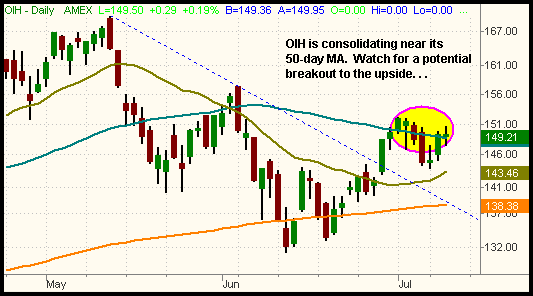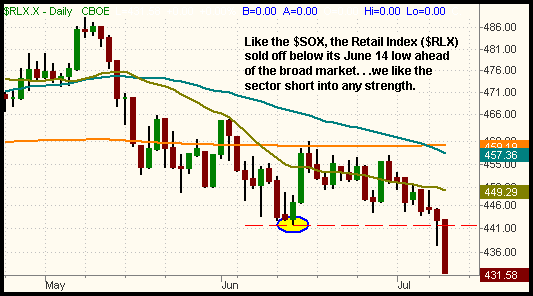The next sector to break down
Tuesday’s bullish reversal day looked
promising, but the broad market sold off sharply yesterday, giving
back all of Tuesday’s gains and then some. The small-cap Russell 2000
(
RUT |
Quote |
Chart |
News |
PowerRating)
and Nasdaq Composite
(
COMP |
Quote |
Chart |
News |
PowerRating) led the way lower, as both indices suffered
1.8% declines. The S&P 500
(
SPX |
Quote |
Chart |
News |
PowerRating) and Dow Jones Industrial Average
(
DJX |
Quote |
Chart |
News |
PowerRating)
each lost 1.1%, while the S&P Midcap 400 fell 1.2%. All of the losses resulted
from the major indices trending steadily lower throughout the day as opposed to
opening gap downs. Most stocks also finished near their intraday lows, pointing
to the likelihood of follow-through downside momentum in this morning’s session.
Total volume in the NYSE declined by 5% yesterday, while
volume in the Nasdaq was 10% lighter than the previous day’s level. Given the
extent of the broad market’s losses, one might have expected to see a
corresponding surge in turnover, but the lower volume tells us that institutions
were not heavily dumping shares. Still, market internals were not pretty.
Declining volume exceeded advancing volume in both exchanges by a ratio of
nearly 4 to 1.
In yesterday’s
Wagner Daily, we
discussed the bullish charts of both the DB Commodity Index
(
DBC |
Quote |
Chart |
News |
PowerRating) and the
StreetTRACKS Gold Trust
(
GLD |
Quote |
Chart |
News |
PowerRating). Not surprisingly, the oil-related ETFs are
also looking good. The Oil Service HOLDR
(
OIH |
Quote |
Chart |
News |
PowerRating) has been consolidating at its
50-day moving average since breaking out above its six-week downtrend line on
June 29. Most likely, the overnight surge to a new record high in the price of
crude oil will cause OIH to break out as well:

In addition to the Oil Service ETFs, remember that the U.S.
Oil Fund
(
USO |
Quote |
Chart |
News |
PowerRating) is an exchange traded fund that roughly follows the price of
crude oil, although not in lockstep. Its composition has actually caused it to
lag the price of crude lately, but it is still an easy and effective way to
trade the price of crude oil without getting involved in futures contracts.
On the downside, it looks like the Retail Index
(
RLX |
Quote |
Chart |
News |
PowerRating) will
be the next sector to break down. With its 2.5% loss yesterday, the $RLX was one
of the worst performing sectors. Like the Semiconductor Index a few days ago,
the Retail Index has also broken down below its prior low from June 14 ahead of
the major indices. This confirms the relative weakness in the sector. The daily
chart of the $RLX below illustrates yesterday’s break of support:

Because the index is breaking down and showing relative
weakness to the broad market, we now like that sector on the short side.
Therefore, we will be stalking the Retail ETFs for possible short sale entries
on any bounce into resistance. This, of course, is always a better bet than
chasing a stock or ETF lower. When selling short, patience to wait for the
proper entry price is crucial. The Retail HOLDR
(
RTH |
Quote |
Chart |
News |
PowerRating) is the most popular of
the retail ETFs, but there are several others. Check out the
free Morpheus ETF Roundup for a complete list of ETFs in that sector.
As for the broad market, the technical picture is beginning to
look pretty bearish again. The S&P 500 broke down and closed below its 200-day
moving average again after holding above it for only eight days. The Nasdaq
Composite also closed right at support of its June 28 low. A break below that
will cause the first “lower low” to form since the uptrend began off the June 14
low. Throughout the late June rally, our intermediate-term view never changed
from bearish, but our short-term bias had switched to bullish. However, both our
short and mid-term biases are now firmly bearish.
Open ETF positions:
Short MDY (regular subscribers to
The Wagner Daily
receive detailed stop and target prices on open positions and detailed setup
information on new ETF trade entry prices. Intraday e-mail alerts are also sent
as needed.)
Deron Wagner is the head trader of Morpheus Capital Hedge Fund and founder of
Morpheus Trading Group (morpheustrading.com),
which he launched in 2001. Wagner appears on his best-selling video, Sector
Trading Strategies (Marketplace Books, June 2002), and is co-author of both The
Long-Term Day Trader (Career Press, April 2000) and The After-Hours Trader
(McGraw Hill, August 2000). Past television appearances include CNBC, ABC, and
Yahoo! FinanceVision. He is also a frequent guest speaker at various trading and
financial conferences around the world. For a free trial to the full version of
The Wagner Daily or to learn about Deron’s other services, visit
morpheustrading.com or send an e-mail to
deron@morpheustrading.com .
Â
